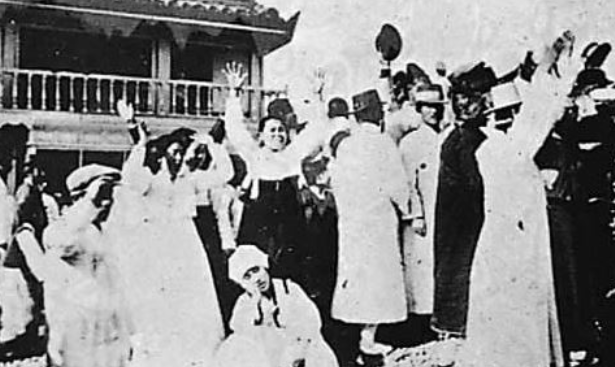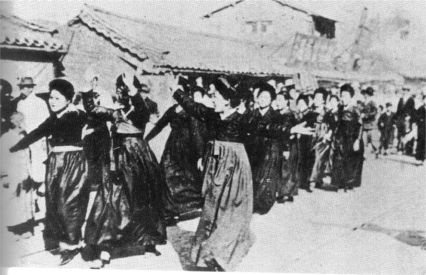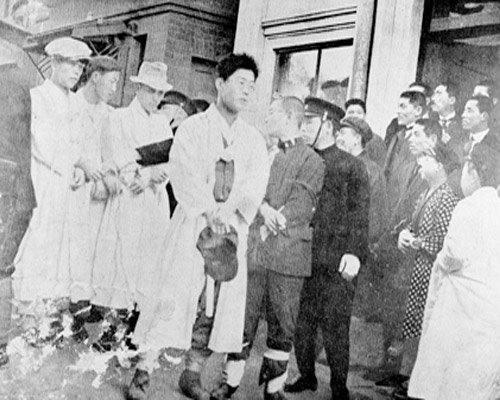On March 1, 1919, Koreans rose up en masse to protest and overthrow Japanese colonial rule. Although the uprising failed, it galvanized and united Koreans through nationalism, and the movement was ultimately enshrined in the constitution of the Republic of Korea. Today, every March 1, Koreans commemorate the insurrection as a national holiday. Protestant churches in Korea also celebrate this day, as the community suffered heavily for their involvement. Although Western Protestant missionaries in Korea did not support the movement officially, they also ended up contributing to it.
The Early Days of Japanese Colonization
Led by Horace Allen and Horace Underwood, long-term American Protestant missionaries began arriving in Korea in 1884. Allen was the first resident missionary to Korea, and Underwood supervised the first translation and publication of the entire Bible into Korean in 1911. Henry Appenzeller laid the foundation of the Methodist church in Korea, while Mary Scranton founded the first women’s college in Korea, now called Ewha Womans University and the largest female university in Asia. The Korea they discovered was an independent kingdom formally known as the Joseon Dynasty, and its monarchs had ruled the Korean peninsula since 1392. By the turn of the 20th century, however, the Neo-Confucian dynasty was under attack by a modernized Japan.
Despite Korean resistance, Japan overturned the dynasty and forcibly annexed Korea in 1910 with the backing of Great Britain and the United States. But missionary activities continued and by 1919, Protestant missionaries in Korea numbered 329 in addition to one Russian Orthodox and 52 Roman Catholic missionaries also residing in Korea. (Koreans brought Catholicism to their own country at the end of the 1700s.) The vast majority of the Protestant missionaries were Americans, followed by British and Australians. Korea’s Christian population numbered around 300,000 in 1919, which was less than 2 percent of the entire Korean population. About 200,000 of them were Protestants.
From early on, missionaries eschewed politics to focus on religious work. Yet because they helped modernize Korea, especially in education and medicine, they were appreciated by Korean reformers. When Japan annexed Korea, Catholic missionaries in Korea complied with Japanese rule. Most Korean Catholics accepted this policy, given a violent 19th century that yielded some 10,000 martyrs. The Protestant missionaries, however, walked a tightrope between the Japanese, whose approval they needed to evangelize, and Korean converts, who tended to be much more resentful of Japanese authorities than the Catholics.
After the onset of Japanese colonization in 1910, two factors spurred the March 1st Movement. The first was Koreans’ persistent desire for independence. This longing was fueled by their historical memory and imagination as one nation stretching back to 2333 BC, when the semi-divine Dangun purportedly founded Korea’s first kingdom, Old Joseon. The second was the repressive first decade of Japanese rule, which saw the Japanese Government General in Seoul engage in ethnic discrimination, systematic terrorism, and torture with its formidable gendarmes.

In January 1918, President Woodrow Wilson’s Fourteen Points speech further catalyzed the March 1st Movement. Nine months after Wilson had persuaded Americans to join the Allies in World War I, Wilson outlined his vision for the post-war world order to a joint session of Congress. Although his speech seemed to promise the right of self-determination to colonized people worldwide, this ideal would turn hollow as it did not apply to colonies held by the Allies, such as Korea. When the speech first aired, however, Korean nationalists embraced it as a clarion call for action.
The first Koreans to organize were in the diaspora, who enjoyed more liberties than their compatriots in Korea and had readier access to global developments. When World War I ended in November 1918, Korean émigrés in China and the United States scrambled to plead their case for Korean independence at the Paris Peace Conference that began in January 1919. They sent representatives to Paris and to Korea to persuade influential Koreans to hold peaceful demonstrations in support of the representatives to Paris.
Their demonstrations aimed to expose the mendacity of Japanese propaganda that Koreans were content under Japanese rule and to proclaim Korean desire for independence. At about the same time, leaders of Cheondogyo, an indigenous Korean religion, also planned peaceful demonstrations. By February 22, 1919, these two religions joined forces. Five days later, they were joined by Buddhists, which completed the triumvirate of religious leadership at the helm of the movement. Thirty-three nationalist leaders inscribed their names on the Korean Declaration of Independence, and its copies were distributed widely.
Christians and Korean Independence
On March 1, 1919, thousands of Koreans—men and women, young and old— gathered at Seoul’s Pagoda Park. At 2 p.m., a young man mounted the platform in the middle of the park and read the Declaration of Independence. As soon as he was finished, the crowd burst into deliriously resounding cheers: “Daehan Dongnip manse!” (Long live Korean independence!) Across the capital and the country, Koreans staged similar demonstrations. Within days, the independence movement erupted in every corner of the nation and in nearly every segment of society. Upwards of two million Koreans participated in more than 1,500 gatherings across all but seven of Korea’s 281 counties.
With their extensive networks and ardent nationalist leaders, Protestants took the lion’s share of leadership in the movement. The significance of their leadership can be gauged from Japanese arrests during the demonstrations. According to a 1919 Japanese military police report, 19,525 Koreans were arrested after the protests and Christians comprised almost 20 percent of all arrests. More than half of the 6,310 religious arrestees were Protestants—an impressive proportion given that they constituted a little over 1 percent of the population in 1919. Furthermore, nearly half of the 489 arrested clergy and two-thirds of the 471 arrested women were Protestants.

The March 1st Movement was planned as a nonviolent protest, but it did not unfold that way. Through peaceful demonstrations, the leaders intended to appeal to the conscience of Japanese colonizers and more importantly to the sympathy of Western victors at the Paris Peace Conference. Instead, the demonstrations only provoked the gendarmes who indiscriminately beat and shot demonstrators with assistance from Japanese residents in Korea. Some demonstrations then turned into violent riots, and only with the arrival of additional Japanese troops did the riots subside. By then, Koreans had suffered heavy casualties: Over 7,500 were killed and 15,000 were injured, while 715 houses, 47 churches, and two schools were substantially destroyed.
Missionary Response to the Uprising
As the March 1st Movement progressed, it became clear that the protests were not spontaneous outbursts. As the Japanese held low opinions of Korean intelligence, many Japanese suspected the foreign missionaries to be organizers and denounced them. “The stirring up of the mind of the Koreans is the sin of the American missionaries,” stated once such denunciation in Chosen Shimbun, a Japanese daily in Korea, published on March 12, 1919. “This uprising is their work. … They take the Wilsonian statement about the self-determination of nations and hide behind their religion to instigate the people.”
Despite such reports, the truth was that these demonstrations surprised missionaries no less than the Japanese. Cognizant that missionaries would not approve, Koreans had not apprised them of the plans for the demonstration. Accused of abetting and aiding the Koreans, the missionaries vigorously denied the Japanese accusation and reaffirmed their political neutrality. Eventually, in mid-March, the Japanese Government General publicly exonerated the missionaries under pressure from the missionaries and the American consulate.

In hindsight, keeping the missionaries in the dark about the Korean independence movement is understandable given the missionaries’ avowed political neutrality. Subsequent developments proved that this decision was prudent. When the protests proliferated, many missionaries instinctively sought to dissuade their Korean converts from participating because of their fear for the converts’ safety stemming from paternalism and because of their fear that their converts’ political actions might jeopardize missionary work. Despite their efforts, however, missionaries could not stem the tide of nationalistic fervor that swept through their schools and churches. Nor could they prevent the bloody crackdown of Japanese authorities.
But after witnessing Japanese atrocities against Koreans, missionaries no longer remained aloof. They became actively involved in caring for the injured and changed their slogan to “no neutrality for brutality.” With moral indignation, they urged Japanese authorities to desist from violence against demonstrators. When their appeals to Japanese fell on deaf ears, missionaries mobilized their overseas contacts. They documented cases of Japanese cruelty and reported to mission boards and influential friends in Europe and America through unofficial channels. About a thousand pages of such dossier were compiled by the Federal Council of the Churches of Christ in America, and a select portion were published in July 1919 as a pamphlet titled The Korean Situation: Authentic Accounts of Recent Events by Eye Witnesses. Among the numerous accounts cited included:
On March 4th, about 12:30 noon, Koreans again engaged in loud cheering. Against this cheering crowd, the Japanese fire brigade was let loose with clubs; some carried pickax handles; others their long lance fir-hooks; some iron bars; others hardwood and pine clubs, as well as short-handled club hooks. They rushed into the crowds, clubbing them over the heads, hooking them here and there with their lance-hooks, until many were seriously wounded in a short time. With blood streaming down their faces, many were dragged to the police station by the fire brigade.
Chung Yung Hui, aged 34, lives in the county of Paiju. On March 28th, at one o’clock in the afternoon, a crowd of 400 yelling “Manse” (Long live Korea) were met by Japanese gendarmes who fired. Eight men were killed. The Koreans had done no violence, and were not even armed with rocks. But this man was shot through the neck.

Such accounts proved to be a public relations nightmare for the Japanese government, as they provoked international outcries and provided ammunition for the critics of Japan in the US Senate. Consequently, Japanese authorities were compelled to renounce using force and to overhaul the draconian colonial policy in Korea.
Through leading the March 1st Movement, Protestants became associated with Korean nationalism, which stimulated the spread of gospels in Korea. Church historian Alfred Wasson wrote in his book Church Grown in Korea, published in 1934, “In each of the other churches in Korea also the year 1920 marks the beginning of a period of growth. … This period of rapid growth was ushered in by the Independence Movement.” Also important, though difficult to quantify, was the renewed trust the missionaries received. “The [Japanese] charges against the missionaries, instead of discrediting them in the minds of the people, put them in greater favor. They were looked upon as comrades in spirit even though they remained neutral in political action.”
Timothy S. Lee is Associate Professor of the History of Christianity at Brite Divinity School in Fort Worth, Texas. He is the author of Born Again: Evangelicalism in Korea (Honolulu: University of Hawaii Press, 2010).









